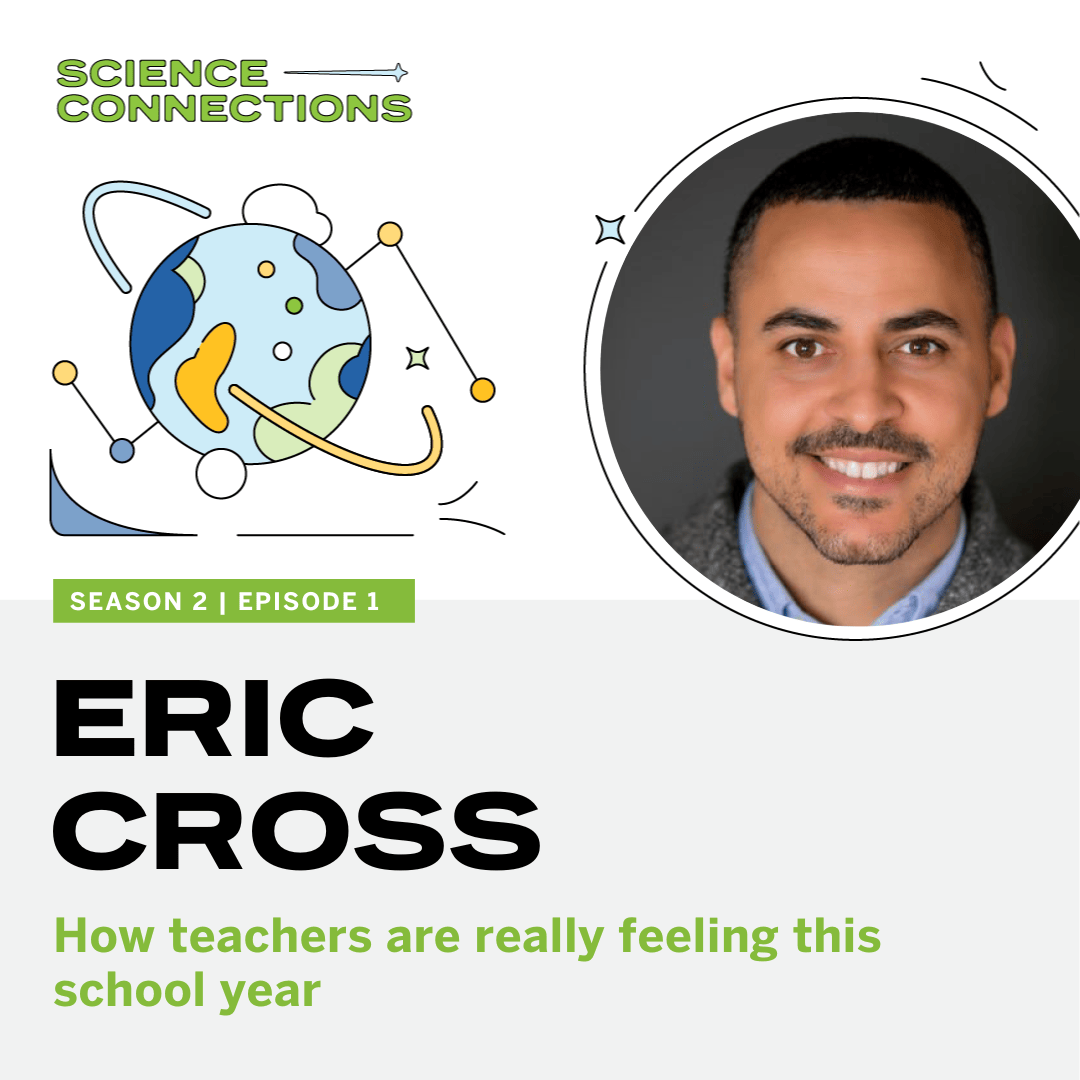
Amplify podcast host and science teacher Eric Cross explores the challenges—and wins—in schools
In this episode of Science Connections: The Podcast, host Eric Cross does things a little differently. Rather than chatting with a guest, Cross takes the mic solo to answer the questions he usually asks his guests.
First, he recounts his own journey to teaching—from brief homelessness to finance to the science classroom. Then, he shares his answers to a current burning question:
How has teaching changed as a result of the pandemic?
There are lots of answers, says Cross. “This could be several podcasts in and of itself. It’s also regional, because everybody’s experienced it differently. Some places have innovated and pivoted. Some places just did what they needed to and they are trying to go back to business as usual. And we’re still experiencing it!”
Read this recap—and listen to the episode—to learn how Cross and his peers see the future of hybrid and personalized learning. You’ll also hear his thoughts on how to go from teacher burnout to teacher inspiration.
Current shifts and revelations in education, from the perspective of a science teacher:
1. More than ever, schools are going beyond content learning.
This has been true for a while, but the pandemic revealed and even increased schools’ ever-expanding role. “For many students, school is where they have their only community, their structure, their emotional wellness,” notes Cross. “They get regular meals, access to tech, and adults that care about them that are outside of their family.”
2. Educator workload is even more intense.
More than ever, says Cross, “You need to be a content expert, a counselor, a trauma-care specialist, a coach, an encourager, a tech expert.” The role of mental health in learning has become even more evident. “How a child feels about themselves, their safety, and their security impacts their ability to learn. So the more comfortable and safe a student feels, the better they learn. And, ultimately, the higher they’re gonna be able to achieve. You can’t have one without the other.”
3. Fewer teachers see themselves teaching forever.
“I read these articles about ‘teacher shortages’ and I think the reality is it’s ‘teacher exodus,” says Cross. “And that’s been difficult. I got a text three days ago from a teacher who said, ‘My goal this year is to just not resign.’ And that’s how a lot of teachers are feeling right now, isolated, challenged, and under-appreciated.”
4. Educational inequity has become more obvious.
“Now the public can see how our kids don’t receive the same quality of education,” says Cross. “Once you see on Zoom or on the news that students in different areas, whether it’s rural South or a suburb in Seattle, are not getting equitable educations, ultimately that impacts all of us.”
5. We’re closing some of the technology gap.
“A lot of schools and districts did an amazing job with deploying hardware, sending out buses with wifi, putting lessons and videos on USB sticks and dropping them off to parents in sparsely populated areas. I’ve heard so many stories about schools and teachers going above and beyond on behalf of kids.”
6. Students and families have more options for personalized learning.
“Some families have said, ‘This hybrid model is better for my child.’ And you know, we talk about personalized learning, but it’s not exactly personalized when everybody has the same schedule, goes to the same classroom of up to 40 kids, and does the same lesson. We have to be honest about our limitations with personalizing learning. So when we can provide more options and we give teachers the infrastructure to use different platforms, we’re able to personalize learning a lot more.”
7. We’ve increased emphasis on whole-child wellness.
“Counseling teams, social workers, school psychologists, I think more than ever we’ve realized the value they bring to the schools. We’re realizing how much we need to honor and support them, and also recruit more. Because as we recognize how our brains are impacted by all things we’re dealing with, we’re also seeing how that’s going to impact student performance.”
8. We’re working to innovate lesson design and assessment.
Cross says that, especially given new challenges in reaching and engaging students, “We’ve been asking, ‘How do we assess what a student knows? How do we make what a student does at school relevant to real life? So there’s been some great conversation around ‘How do we rethink what education looks like?’”
It’s crucial, especially now, for teachers to ask and answer those questions, says Cross—especially together. “It’s important for us as teachers to stay connected to those people who are pushing the boundaries and thinking outside the box. When we get siloed, it’s easy to get calcified and cynical. But when we’re around people who have fresh ideas, it inspires us.”
Listen to the whole podcast episode here and subscribe to Science Connections: The Podcast here.
About Amplify’s Science Connections: The Podcast
Science is changing before our eyes, now more than ever. So how do we help kids figure that out? How are we preparing students to be the next generation of 21st-century scientists?
Join host Eric Cross as he sits down with educators, scientists, and knowledge experts to discuss how we can best support students in science classrooms. Listen to hear how you can inspire kids across the country to love learning science, and bring that magic into your classroom for your students.



